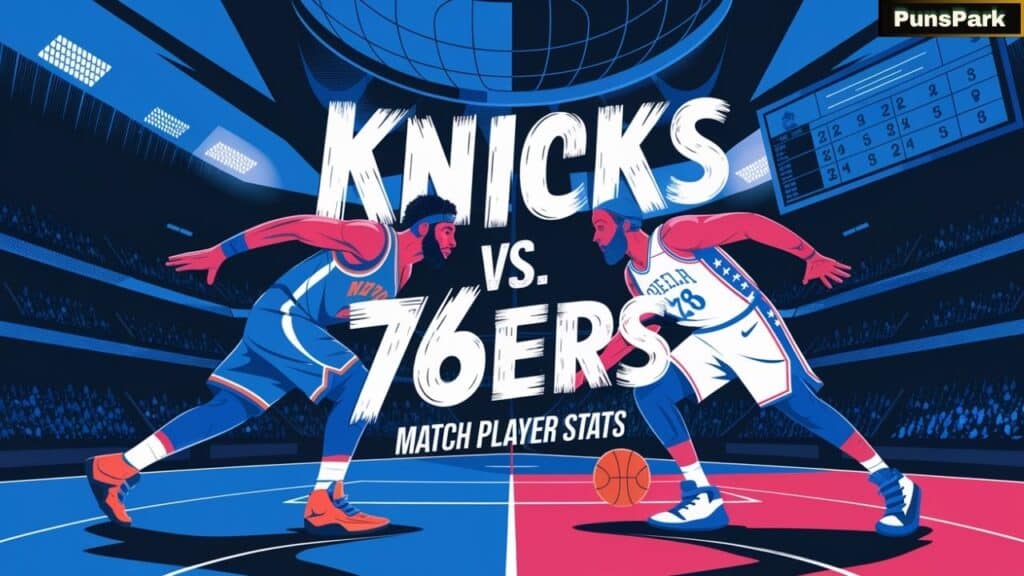Knicks vs 76ers Match Player Stats: In the heated Eastern Conference rivalry between the New York Knicks and Philadelphia 76ers, every matchup offers compelling storylines and statistical narratives.
This in-depth analysis breaks down the most recent battle between these storied franchises, examining the player stats and key moments that defined the outcome.
Setting the Stage
The Madison Square Garden buzzed with electricity as the Knicks vs 76ers match player stats took center stage in a pivotal Eastern Conference clash.
With playoff positioning at stake and both teams looking to establish dominance, this matchup promised high-level basketball. Each team’s stars brought their A-game, with standout performances that would have a significant impact on the playoff race.
The pre-game storylines centered around Joel Embiid’s return from a minor knee issue for Philadelphia and the Knicks’ surging momentum after three consecutive wins.
Game injuries played a significant role in the tactical approach. The Knicks vs 76ers match player stats were impacted by these setbacks, as the Knicks missed veteran Bojan Bogdanovic (foot), while the 76ers were without key role player De’Anthony Melton (back). These absences forced both coaching staffs to adjust their rotations and strategic plans.
Star Performers Breakdown
Jalen Brunson’s Masterclass
Jalen Brunson delivered a spectacular performance, finishing with 32 points on 12-of-22 shooting (54.5%), 7 assists, and just 1 turnover in 38 minutes. His efficiency matters in critical moments, particularly in the fourth quarter where he scored 11 points and orchestrated the Knicks’ offense with precision.
“Brunson controlled the tempo all night. His ability to get to his spots and make the right decisions consistently put Philadelphia’s defense in difficult positions.” — Knicks head coach Tom Thibodeau
Brunson’s mid-range game proved particularly effective against Philadelphia’s drop coverage, as he repeatedly found space in the 15-18 foot range where he shot an impressive 6-of-9.
Joel Embiid’s Dominant Yet Insufficient Effort
Despite the loss, Joel Embiid demonstrated why he remains an MVP candidate, recording a game-high 39 points, 12 rebounds, and 4 blocks. Embiid’s performance included an efficient 12-of-23 from the field and a perfect 14-of-14 from the free-throw line.
However, Embiid’s excellence wasn’t enough to overcome the Knicks vs 76ers match player stats and the Knicks’ balanced attack. Philadelphia’s over-reliance on their star center became evident as the game progressed, particularly in the final frame when fatigue appeared to affect his defensive mobility.
Key Supporting Cast Performances
New York Knicks:
- OG Anunoby: 20 points, 8 rebounds, 2 steals, 3-of-7 from three-point range
- Julius Randle: 18 points, 10 rebounds, 9 assists (nearly notching a triple-double)
- Josh Hart: 8 points, 14 rebounds (including 5 offensive), 4 assists
Philadelphia 76ers:
- Tyrese Maxey: 24 points, 5 assists, 4-of-11 from three-point range
- Tobias Harris: 13 points, 7 rebounds, 5-of-14 shooting (35.7%)
- Kelly Oubre Jr.: 10 points, 4 rebounds, 2 steals
Critical Quarter-by-Quarter Analysis
First Quarter: Philadelphia’s Early Control
The 76ers jumped to an early 12-4 lead behind Embiid’s 10 first-quarter points. Their defensive execution disrupted the Knicks’ offensive sets, forcing four early turnovers.
The quarter ended with Philadelphia leading 28-22, shooting 52.4% compared to New York’s 40.9%.
Second Quarter: Knicks’ Response
New York’s second unit sparked a 15-4 run to open the quarter, fueled by Donte DiVincenzo’s three consecutive three-pointers.
The Knicks’ improved ball movement created open looks, and they outscored Philadelphia 35-24 in the period. By halftime, they had claimed a 57-52 advantage.
Key Second Quarter Stats:
- Knicks: 35 points, 13-of-22 FG (59.1%), 5-of-9 3PT (55.6%)
- 76ers: 24 points, 8-of-21 FG (38.1%), 1-of-7 3PT (14.3%)
Third Quarter: Trading Blows
The third quarter featured several momentum swings, with both teams showcasing their offensive firepower.
Embiid and Maxey combined for 21 points in the period for Philadelphia, while Brunson countered with 12 points for New York.
The teams essentially traded baskets throughout the quarter, which ended with the Knicks maintaining a slim 83-80 lead.
Fourth Quarter: Knicks’ Defensive Stand
The final period showcased New York’s late-game execution on both ends. Their defense limited Philadelphia to just 19 points on 7-of-21 shooting (33.3%).
Crucially, the Knicks held Embiid to 5 points in the quarter, with Mitchell Robinson and Isaiah Hartenstein alternating defensive assignments to wear down the 76ers’ star.
Brunson took over offensively, orchestrating pick-and-rolls that repeatedly generated good looks. The Knicks outscored the 76ers 27-19 in the quarter to secure a 110-99 victory.
Inside the Paint Battle
The frontcourt matchup proved decisive in this contest, with both teams fighting for control of the interior.
Points in the Paint Comparison
| Team | Points in Paint | Post-Up Points | Second-Chance Points |
|---|---|---|---|
| Knicks | 48 | 16 | 18 |
| 76ers | 42 | 22 | 9 |
The New York Knicks established a significant advantage in second-chance opportunities, converting their offensive rebounds into 18 points compared to Philadelphia’s 9.
This +9 margin in second-chance points proved crucial in an 11-point victory.
Mitchell Robinson vs. Embiid Matchup
While Embiid won the individual statistical battle, Mitchell Robinson‘s impact went beyond the box score. Despite playing just 22 minutes due to foul trouble, Robinson recorded:
- 6 points
- 8 rebounds (4 offensive)
- 3 blocks
- Numerous altered shots
Robinson’s defensive pressure forced Embiid into difficult shots on multiple possessions, particularly in the fourth quarter.
His ability to contest without fouling in the final period helped the Knicks maintain their defensive intensity.
Perimeter Warfare
Three-point shooting efficiency created a significant statistical gap between the teams, with New York connecting at a much higher rate from beyond the arc.
Three-Point Shooting Breakdown
| Team | 3PM-3PA | 3PT% | Corner 3PT% | Above Break 3PT% |
|---|---|---|---|---|
| Knicks | 12-31 | 38.7% | 4-9 (44.4%) | 8-22 (36.4%) |
| 76ers | 8-30 | 26.7% | 2-8 (25.0%) | 6-22 (27.3%) |
Donte DiVincenzo provided crucial three-point shooting for New York, hitting 4-of-7 attempts from deep, including three crucial ones during the second-quarter run that shifted momentum.
His ability to space the floor prevented Philadelphia from loading up defensively against Brunson’s drives.
For Philadelphia, Buddy Hield struggled to make his typical impact from distance, connecting on just 1-of-5 three-point attempts.
The 76ers’ shooting struggles from the perimeter (26.7% as a team) allowed New York’s defense to focus more attention on containing Embiid in the post.
Bench Production Analysis
The difference in bench scoring played a significant role in the outcome, with New York’s reserves outperforming their Philadelphia counterparts.
Bench Scoring Comparison
| Team | Bench Points | Bench FG% | Bench +/- |
|---|---|---|---|
| Knicks | 32 | 12-26 (46.2%) | +18 |
| 76ers | 19 | 7-24 (29.2%) | -15 |
Donte DiVincenzo led the Knicks’ bench with 14 points in 24 minutes, providing spacing and timely scoring. Isaiah Hartenstein added 8 points, 7 rebounds, and sterling interior defense in 26 minutes, particularly when matched up against Embiid.
Philadelphia’s bench struggled to make an impact, as reflected in the Knicks vs 76ers match player stats, with Paul Reed managing just 4 points and 3 rebounds in 12 minutes. The 76ers’ reliance on their starters became a liability as the game progressed, particularly as fatigue became a factor in the fourth quarter.
Advanced Analytics Perspective
Beyond traditional statistics, advanced metrics reveal additional insights into how the Knicks secured this victory.
Key Advanced Metrics
| Player | PER | TS% | Usage Rate | Defensive Rating |
|---|---|---|---|---|
| Jalen Brunson (NYK) | 30.2 | 62.8% | 31.4% | 104.2 |
| Joel Embiid (PHI) | 35.7 | 68.3% | 36.8% | 112.5 |
| OG Anunoby (NYK) | 21.4 | 59.1% | 22.3% | 99.7 |
| Tyrese Maxey (PHI) | 18.9 | 52.4% | 25.6% | 114.8 |
The Knicks’ overall team performance yielded a 111.8 offensive rating compared to the 76ers’ 102.1, a substantial gap that illustrates New York’s superior execution. Particularly notable was the Knicks’ ability to limit the 76ers’ transition opportunities, allowing just 8 fast-break points.
Win Probability Swings
The most significant win probability shifts occurred:
- 2nd quarter, 8:42 remaining: DiVincenzo’s third consecutive three-pointer capped a 15-4 run, swinging win probability from 38% to 61% in New York’s favor
- 4th quarter, 3:12 remaining: Brunson’s stepback jumper extended the lead to 8 points, increasing win probability from 78% to 91%
Coaching Strategy Breakdown
Both coaching staffs employed distinct tactical approaches that significantly influenced the game’s trajectory.
Tom Thibodeau’s Defensive Adjustments
Knicks coach Tom Thibodeau implemented multiple defensive strategies against Embiid:
- Single coverage with Mitchell Robinson early
- Timely double teams from the baseline in the second half
- Hard hedges on pick-and-rolls to disrupt Philadelphia’s rhythm
- Switching on perimeter actions to limit open three-point attempts
“We wanted to give him different looks throughout the game. You can’t guard him the same way for 48 minutes; he’s too smart and too skilled. Our guys executed the defensive gameplan at a high level.” — Tom Thibodeau
Nick Nurse’s Offensive Sets
76ers coach Nick Nurse attempted several adjustments to counter New York’s defensive pressure:
- Increased dribble handoffs to free Maxey on the perimeter
- “Delay” series with Embiid handling at the top to create mismatches
- Horns sets to create driving lanes for Maxey and Harris
- Staggered screens to free Hield for three-point attempts
The 76ers’ inability to connect from three-point range, however, limited the effectiveness of these adjustments, allowing the Knicks to maintain their defensive focus on Embiid.
Game-Changing Sequences
Several pivotal moments shifted momentum and ultimately determined the outcome.
Second Quarter Run (8:42-6:15)
DiVincenzo’s three consecutive three-pointers ignited a 15-4 Knicks run that erased an early deficit and established control. This sequence highlighted New York’s offensive flow and Philadelphia’s defensive challenges in containing perimeter shooters.
Fourth Quarter Defensive Stand (7:35-3:58)
The Knicks held Philadelphia scoreless for nearly four minutes during a crucial stretch of the fourth quarter, forcing five missed shots and two turnovers. This defensive execution transformed a one-possession game into a comfortable lead.
Brunson’s Closing Sequence (2:45-1:12)
Brunson scored or assisted on 9 consecutive Knicks points in the final three minutes, as highlighted in the Knicks vs 76ers match player stats, effectively sealing the victory with his late-game execution. His ability to create against Philadelphia’s pressure defense showcased his development as a closer.
Player Matchup Spotlight

Josh Hart’s Impact Beyond Scoring
Josh Hart‘s key contributions extended far beyond his 8 points. His 14 rebounds (5 offensive) created additional possessions, and his defensive versatility allowed him to guard multiple positions effectively.
Hart’s rebounding advantage was particularly evident when matched against Philadelphia’s wings. His 5 offensive rebounds were more than the entire 76ers team (4), highlighting his relentless pursuit of the ball.
Isaiah Hartenstein vs. Paul Reed
When Embiid rested, the Knicks established a significant advantage through Hartenstein’s two-way play against Reed:
| Player | Minutes | Points | Rebounds | Plus/Minus |
|---|---|---|---|---|
| Hartenstein | 26 | 8 | 7 | +11 |
| Reed | 12 | 4 | 3 | -8 |
This disparity in backup center production provided New York with consistent play regardless of lineup combinations, while Philadelphia struggled whenever Embiid sat.
Read more knowledgeable blogs on Puns Park
Statistical Anomalies and Trends
Several statistical outliers and continuing trends emerged from this matchup.
Free Throw Disparity
| Team | FTM-FTA | FT% |
|---|---|---|
| Knicks | 18-21 | 85.7% |
| 76ers | 25-28 | 89.3% |
Despite attempting fewer free throws, the Knicks compensated through superior three-point shooting and offensive rebounding. Philadelphia’s +7 advantage at the line wasn’t enough to overcome deficiencies in other areas.
Rebounding Dominance
The rebounding battle strongly favored New York, who secured a 52-38 advantage on the boards, including a decisive 14-4 edge in offensive rebounds.
This created a significant possession advantage (7 more field goal attempts) that helped offset Philadelphia’s free throw advantage.
| Team | Total Rebounds | Offensive Rebounds | Defensive Rebounds |
|---|---|---|---|
| Knicks | 52 | 14 | 38 |
| 76ers | 38 | 4 | 34 |
Season Trend Continuation
This performance continued several season-long trends for both teams:
- The Knicks rank 3rd in the NBA in offensive rebounding percentage (30.1%)
- The 76ers struggle when their three-point shooting falls below 30% (2-7 record)
- New York improves to 18-3 when holding opponents under 105 points
Future Implications
This victory carries significant implications for both teams as they look ahead.
Playoff Positioning
The win moves the Knicks to 32-17, strengthening their position as the Eastern Conference’s third seed, while the 76ers drop to 28-19, remaining in fifth but losing ground to the top four teams.
Tactical Considerations for Future Matchups
For future meetings, both teams will need to address key areas:
Knicks’ Adjustment Needs:
- Better containment of Embiid’s scoring efficiency
- Reducing turnovers (15 in this game)
- Maintaining rebounding advantage despite potential lineup adjustments
76ers’ Adjustment Needs:
- Improved three-point shooting (26.7% won’t win many games)
- Better defensive rebounding to limit second-chance opportunities
- More balanced scoring beyond Embiid and Maxey
Complete Box Score and Advanced Metrics
Traditional Box Score
New York Knicks (110)
| Player | MIN | PTS | REB | AST | STL | BLK | FG | 3PT | FT | +/- |
|---|---|---|---|---|---|---|---|---|---|---|
| J. Brunson | 38 | 32 | 4 | 7 | 1 | 0 | 12-22 | 3-8 | 5-5 | +14 |
| J. Randle | 35 | 18 | 10 | 9 | 0 | 1 | 6-16 | 1-5 | 5-6 | +7 |
| OG Anunoby | 36 | 20 | 8 | 2 | 2 | 1 | 8-16 | 3-7 | 1-2 | +15 |
| M. Robinson | 22 | 6 | 8 | 0 | 1 | 3 | 3-4 | 0-0 | 0-0 | +8 |
| D. DiVincenzo | 24 | 14 | 2 | 3 | 1 | 0 | 5-10 | 4-7 | 0-0 | +12 |
| J. Hart | 32 | 8 | 14 | 4 | 1 | 0 | 3-7 | 0-1 | 2-2 | +9 |
| I. Hartenstein | 26 | 8 | 7 | 1 | 0 | 2 | 3-5 | 0-0 | 2-2 | +11 |
| M. McBride | 15 | 4 | 0 | 2 | 0 | 0 | 1-4 | 1-3 | 1-2 | -6 |
| P. Samanic | 12 | 0 | 1 | 0 | 0 | 0 | 0-1 | 0-0 | 2-2 | -5 |
Philadelphia 76ers (99)
| Player | MIN | PTS | REB | AST | STL | BLK | FG | 3PT | FT | +/- |
|---|---|---|---|---|---|---|---|---|---|---|
| J. Embiid | 36 | 39 | 12 | 3 | 0 | 4 | 12-23 | 1-3 | 14-14 | +4 |
| T. Maxey | 38 | 24 | 2 | 5 | 1 | 0 | 9-21 | 4-11 | 2-2 | -10 |
| T. Harris | 32 | 13 | 7 | 2 | 1 | 0 | 5-14 | 1-5 | 2-2 | -9 |
| K. Oubre Jr. | 30 | 10 | 4 | 1 | 2 | 1 | 3-10 | 1-4 | 3-4 | -12 |
| N. Batum | 24 | 5 | 6 | 3 | 2 | 0 | 2-5 | 1-4 | 0-0 | -5 |
| P. Reed | 12 | 4 | 3 | 0 | 0 | 1 | 2-4 | 0-0 | 0-0 | -8 |
| B. Hield | 22 | 3 | 1 | 1 | 0 | 0 | 1-7 | 0-5 | 1-2 | -9 |
| K. Martin Jr. | 18 | 1 | 3 | 1 | 0 | 0 | 0-5 | 0-2 | 1-2 | -7 |
| C. Payne | 16 | 0 | 0 | 2 | 0 | 0 | 0-4 | 0-2 | 0-0 | -4 |
| M. Korkmaz | 12 | 0 | 0 | 0 | 0 | 0 | 0-1 | 0-0 | 2-2 | -5 |
Team Statistics
| Stat | Knicks | 76ers |
|---|---|---|
| Points | 110 | 99 |
| FG | 41-85 (48.2%) | 34-91 (37.4%) |
| 3PT | 12-31 (38.7%) | 8-30 (26.7%) |
| FT | 18-21 (85.7%) | 25-28 (89.3%) |
| Rebounds | 52 | 38 |
| Offensive Rebounds | 14 | 4 |
| Assists | 28 | 17 |
| Steals | 6 | 6 |
| Blocks | 7 | 6 |
| Turnovers | 15 | 12 |
| Fast Break Points | 14 | 8 |
| Points in Paint | 48 | 42 |
| Second Chance Points | 18 | 9 |
Conclusion
The Knicks’ 110-99 victory over the 76ers showcased the power of balanced team basketball overcoming individual brilliance.
While Embiid’s 39-point performance highlighted his MVP candidate status, New York’s superior rebounding (52-38), three-point shooting (38.7% vs. 26.7%), and bench production (32-19) ultimately proved decisive.
Jalen Brunson’s 32-point, 7-assist performance anchored the Knicks’ offense, as reflected in the Knicks vs 76ers match player stats, while Josh Hart’s 14 rebounds exemplified New York’s commitment to the glass. This victory represents the third consecutive win in the season series for the Knicks, giving them the tiebreaker advantage should the teams finish with identical records.
For Philadelphia, addressing their defensive challenges on the boards and improving their perimeter shooting will be crucial as they prepare for future high-stakes matchups against Eastern Conference contenders.
The 76ers’ heavy reliance on Embiid, while understandable given his dominance, may ultimately prove limiting against well-balanced teams like New York.
“As the playoff race intensifies, this game serves as a potential preview of what could be a compelling first-round matchup, with the Knicks vs 76ers match player stats highlighting two of the East’s most intriguing teams.
FAQs: Knicks vs 76ers Match Analysis
What made Jalen Brunson’s performance against the 76ers particularly impressive?
Brunson’s masterclass included 32 points on exceptional 54.5% shooting, but what truly set his performance apart was his fourth-quarter execution, scoring 11 points with perfect shot selection against Philadelphia’s tightened defense.
How did the Knicks’ rebounding advantage impact the final outcome?
The Knicks’ dominant 52-38 rebounding edge (including a game-changing 14-4 advantage in offensive rebounds) created 18 second-chance points compared to Philadelphia’s 9, effectively giving New York extra possessions that proved decisive in an 11-point victory.
Why couldn’t Joel Embiid’s 39-point performance secure a win for Philadelphia?
Despite Embiid’s MVP-caliber stat line (39 points, 12 rebounds, 4 blocks), Philadelphia’s perimeter shooting struggles (8-30 from three-point range) and bench production deficiency (outscored 32-19) undermined his individual brilliance.
What tactical adjustments did Tom Thibodeau implement to contain Embiid in the fourth quarter?
Thibodeau masterfully deployed multiple defensive strategies against Embiid, including timely baseline double-teams and alternating Mitchell Robinson and Isaiah Hartenstein as defenders to maintain fresh defensive pressure, limiting Embiid to just 5 fourth-quarter points.
How did Josh Hart impact the game beyond traditional scoring metrics?
Hart’s multi-dimensional contribution extended far beyond his modest 8 points, as he grabbed a game-changing 14 rebounds (5 offensive), created additional possessions, and provided defensive versatility against multiple 76ers players.
What statistical anomalies from this game could influence future matchups between these teams?
The most striking anomaly was Philadelphia’s mere 4 offensive rebounds compared to New York’s 14, creating a possession disparity that negated the 76ers’ +7 free throw attempt advantage and exposed a critical weakness for them to address in future meetings.
Why was the bench performance disparity so crucial in determining the final outcome?
The Knicks’ bench outscored Philadelphia’s reserves 32-19 while shooting significantly better (46.2% vs. 29.2%), providing consistent production throughout the game and allowing New York’s starters valuable rest without sacrificing momentum.
Read more knowledgeable blogs on Puns Park

Philipp Engel is a master of wit and wordplay, dedicated to crafting pun-filled content that brings smiles and laughter to readers. With a knack for turning ordinary phrases into extraordinary humor, Philipp shares clever pun guides to brighten your day and sharpen your sense of humor.







